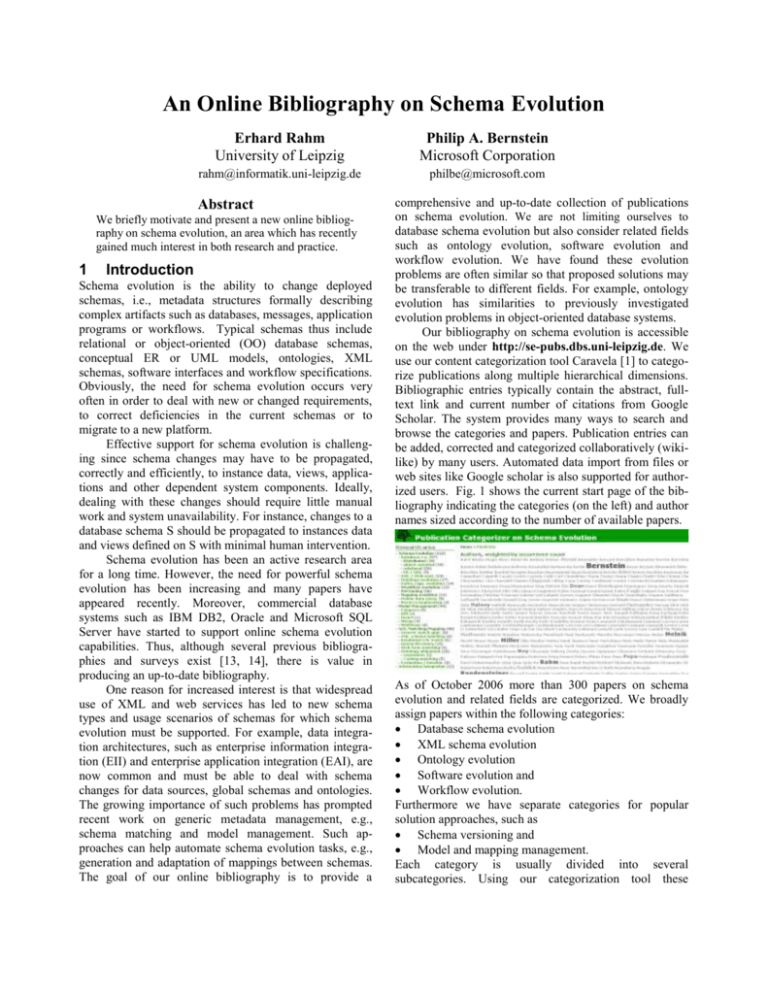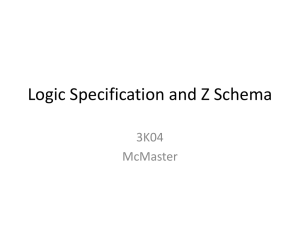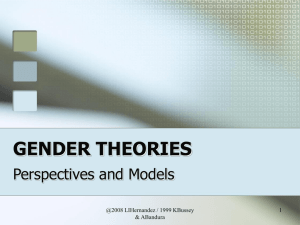tr-2006-141
advertisement

An Online Bibliography on Schema Evolution Erhard Rahm University of Leipzig Philip A. Bernstein Microsoft Corporation rahm@informatik.uni-leipzig.de philbe@microsoft.com Abstract We briefly motivate and present a new online bibliography on schema evolution, an area which has recently gained much interest in both research and practice. 1 Introduction Schema evolution is the ability to change deployed schemas, i.e., metadata structures formally describing complex artifacts such as databases, messages, application programs or workflows. Typical schemas thus include relational or object-oriented (OO) database schemas, conceptual ER or UML models, ontologies, XML schemas, software interfaces and workflow specifications. Obviously, the need for schema evolution occurs very often in order to deal with new or changed requirements, to correct deficiencies in the current schemas or to migrate to a new platform. Effective support for schema evolution is challenging since schema changes may have to be propagated, correctly and efficiently, to instance data, views, applications and other dependent system components. Ideally, dealing with these changes should require little manual work and system unavailability. For instance, changes to a database schema S should be propagated to instances data and views defined on S with minimal human intervention. Schema evolution has been an active research area for a long time. However, the need for powerful schema evolution has been increasing and many papers have appeared recently. Moreover, commercial database systems such as IBM DB2, Oracle and Microsoft SQL Server have started to support online schema evolution capabilities. Thus, although several previous bibliographies and surveys exist [13, 14], there is value in producing an up-to-date bibliography. One reason for increased interest is that widespread use of XML and web services has led to new schema types and usage scenarios of schemas for which schema evolution must be supported. For example, data integration architectures, such as enterprise information integration (EII) and enterprise application integration (EAI), are now common and must be able to deal with schema changes for data sources, global schemas and ontologies. The growing importance of such problems has prompted recent work on generic metadata management, e.g., schema matching and model management. Such approaches can help automate schema evolution tasks, e.g., generation and adaptation of mappings between schemas. The goal of our online bibliography is to provide a comprehensive and up-to-date collection of publications on schema evolution. We are not limiting ourselves to database schema evolution but also consider related fields such as ontology evolution, software evolution and workflow evolution. We have found these evolution problems are often similar so that proposed solutions may be transferable to different fields. For example, ontology evolution has similarities to previously investigated evolution problems in object-oriented database systems. Our bibliography on schema evolution is accessible on the web under http://se-pubs.dbs.uni-leipzig.de. We use our content categorization tool Caravela [1] to categorize publications along multiple hierarchical dimensions. Bibliographic entries typically contain the abstract, fulltext link and current number of citations from Google Scholar. The system provides many ways to search and browse the categories and papers. Publication entries can be added, corrected and categorized collaboratively (wikilike) by many users. Automated data import from files or web sites like Google scholar is also supported for authorized users. Fig. 1 shows the current start page of the bibliography indicating the categories (on the left) and author names sized according to the number of available papers. As of October 2006 more than 300 papers on schema evolution and related fields are categorized. We broadly assign papers within the following categories: Database schema evolution XML schema evolution Ontology evolution Software evolution and Workflow evolution. Furthermore we have separate categories for popular solution approaches, such as Schema versioning and Model and mapping management. Each category is usually divided into several subcategories. Using our categorization tool these categories can easily be extended or refined as needed, i.e., we support evolution of the categorization schema. In the following we briefly list some specific aspects of the research categories covered by the bibliography. versions of schemas. Although versioning is rarely used for database schema evolution, it is a very common approach to software evolution and will likely be important for XML, web service, and ontology evolution. 2 2.7 2.1 Research categories Database schema evolution Some papers characterize types of schema changes for different data models, in particular relational, objectoriented (OO) and XML databases. These changes can be propagated to instances of the schema immediately or lazily. They may also be propagated to dependent views, something that today’s commercial database systems do automatically for simpler schema changes (e.g., 1 table). There are many papers on schema evolution for OO database systems [2,11], since evolution is intrinsic to the design processes they support. By contrast, there are still relatively few papers on schema evolution in distributed systems―possibly a good opportunity for future research. 2.2 XML schema evolution The semi-structured nature of XML offers more flexibility in coping with schema changes and lower cost, due to such features as optionality of schema parts and multiple schemas per database [4]. 2.3 3 Ontology evolution 1. Ontologies exhibit the same evolution problems as database schemas, but have some different constructs, such as controlled vocabularies, taxonomies, and rulebased knowledge representation, and hence have some different types of changes. Often, an ontology contains both schema-like conceptual metadata plus its instances; changes to metadata and instances need to be considered together. A domain ontology may be used in many applications, resulting in dependencies between distributed systems. So far, most papers focus on ontology matching and versioning aspects of evolution [6, 7]. 2.4 2. 3. 4. 5. 6. Software evolution The generation of a new software version shares many of the problems of schema evolution. Instead of schemas, we have program interfaces or class hierarchies. Instead of mappings or views, we have usage relationships and dependencies between program modules. Research papers classify different software evolution and maintenance scenarios [8]. Many papers focus especially on objectoriented software development [9]. Some describe change support tools. 2.5 7. 8. 9. 10. 11. Workflow evolution Workflows are long-running activities. Instead of schemas and databases, we have workflow specifications and executing workflow instances. So changing a workflow specification (e.g., change/add/drop an activity) requires different actions than changing a database schema [5]. 2.6 Model and mapping management High-level operators on schemas and mappings are useful for generating views and other mappings and adapting them after schema changes. There is a big literature on schema matching [12], which can help determine what has changed. Schema evolution is a simple case for schema matching since most of the schema remains unchanged. Given a result from schema matching, there are query discovery techniques [10] to generate an executable (instance-level) mapping between the old and evolved schema. Given a mapping from an evolved schema to the old schema and an existing view over the old schema, mapping composition can be used to produce an updated view [15]. Scripts of match, compose and other operators have been published for a variety of complex schema evolution scenarios [3]. 12. 13. 14. Version management One major approach to schema evolution is the use of user-controlled, explicit versions [7, 14]. For example, the need to propagate changes is reduced by preserving older 15. 2 References Aumüller, D., Rahm, E.: Caravela: Semantic Content Management with Automatic Categorization. Univ. of Leipzig, 2006 Banerjee, J.; Kim, W.; Kim, H.; Korth, H. F. Semantics and Implementation of Schema Evolution in Object-Oriented Databases. Proc. SIGMOD 1987 Bernstein, P.A.: Applying Model Management to Classical Meta Data Problems. Proc. CIDR 2003 Beyer, K.; Oezcan, F.; Saiprasad, S.; Van der Linden, B.: DB2/XML: Designing for Evolution. Proc. SIGMOD 2005. Casati, I.; Ceri, S.; Pernici, B.; Pozzi, G. Workflow Evolution. Proc. Int. Conf. on Conceptual Modeling (ER), 1996 Doan, A.; Madhavan, J.; Domingos, P.; Halevy, A.: Learning to Map between Ontologies on the Semantic Web. Proc. WWW2002 Klein, M.; Fensel, D.: Ontology Versioning on the Semantic Web. Proc. Int. Semantic Web Working Symposium, 2001 Lehman, M.M; Ramil, J.F.: Software Evolution - Background, Theory, Practice. Inf. Process. Lett. 88(1-2), 2003 Lieberherr, K.J., Xiao, C.: Object-Oriented Software Evolution. IEEE Trans. Software Eng. 19(4), 1993 Miller, R.; Haas, L.; Hernandez, M.: Schema Mapping as Query Discovery. Proc. 26th VLDB, 2000 Ra, Y; Rundensteiner, E.: A Transparent Schema-Evolution System Based on Object-Oriented View Technology. IEEE Trans. Knowledge and Data Eng 9(4), 1997 Rahm, E.; Bernstein, P. A.: A Survey of Approaches to Automatic Schema Matching. VLDB Journal, 2001 Roddick, J.F.: Schema Evolution in Database Systems: An Annotated Bibliography. SIGMOD Record 21(4), 1992 Roddick, J.F.: Survey of Schema Versioning Issues for Database Systems. Information and Software Technology, 37(7), 1995 Yu, C.; Popa, L.: Semantic Adaptation of Schema Mappings when Schemas Evolve. Proc. VLDB 2005







